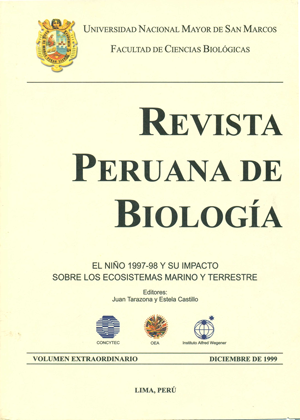Meteorological conditions to global and local level, climate change and "El Niño 1997-98"
DOI:
https://doi.org/10.15381/rpb.v6i3.8425Keywords:
Eastern Pacific Ocean, atmosphere, El Niño, climate changeAbstract
"El Niño 1997-98" event showed both a rapid and intense evolution, developing as one of the strongest on both central and eastern equatorial Pacific of the last 150 years. The seawater warming induced by "El Niño 1997-98" in Peruvian coas! began in March 1997, with incursion 01 both subtropical and equatorial water. The atmospheric and oceanic conditions to macroscale kept and reached their maximum intensity in November and December 1997. The Intertropical Convergence Zone was displaced southward major part of 1997. "El Niño" affected the country weather since the beginning 01 autumn 1997. That winter was one of the warmest of Peruvian history, with anomalies that gel to 6°C in central coast. Likewise, atmospheric pressure drops were recorded in eastern Pacific; rain that overcome the average in both middle and high north Peruvian coast significantly; and normal and slight deficient rain in Highland, particularly in the south of the country.Downloads
Downloads
Published
Issue
Section
License
Copyright (c) 1999 Ena Jaimes

This work is licensed under a Creative Commons Attribution-NonCommercial-ShareAlike 4.0 International License.
AUTHORS RETAIN THEIR RIGHTS:
a. Authors retain their trade mark rights and patent, and also on any process or procedure described in the article.
b. Authors retain their right to share, copy, distribute, perform and publicly communicate their article (eg, to place their article in an institutional repository or publish it in a book), with an acknowledgment of its initial publication in the Revista Peruana de Biologia.
c. Authors retain theirs right to make a subsequent publication of their work, to use the article or any part thereof (eg a compilation of his papers, lecture notes, thesis, or a book), always indicating its initial publication in the Revista Peruana de Biologia (the originator of the work, journal, volume, number and date).






